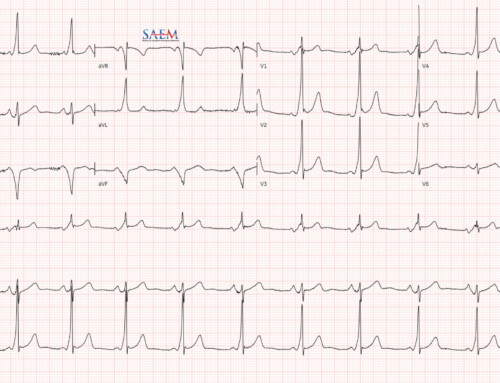 Acute coronary syndrome (ACS) is the number one cause of mortality in patients older than 65 years old. 1 To complicate this fact further, they also present atypically with weakness, nausea/vomiting, fatigue, and shortness of breath. It has been shown that older adults who present to the emergency department (ED) with ACS and a chief complaint other than chest pain have worse outcomes:
Acute coronary syndrome (ACS) is the number one cause of mortality in patients older than 65 years old. 1 To complicate this fact further, they also present atypically with weakness, nausea/vomiting, fatigue, and shortness of breath. It has been shown that older adults who present to the emergency department (ED) with ACS and a chief complaint other than chest pain have worse outcomes:
- Higher in-hospital mortality 1
- Misdiagnosed 2
- Undertreated 3
If this does not concern you enough as an ED physician, then just know that the risk of death continues 30 days to one year after hospitalization with mortality rates of 15% for adults aged 75 to 85 years and 25% for adults older than 85 years. 1
What is the most common presenting symptom of older adults with ACS? 4
- Chest pain (58 – 83.4%) — More common in men
- Shortness of breath (23 – 65.3%)
- Diaphoresis (4 – 56.8%)
- Nausea (7 – 45.3%) — More common in women
How long do older adults with ACS wait before seeking care at the ED? 5
- More than 50% of older adults wait 2 hours – 2.5 days before seeking care
- Only 10 – 14% present to the ED within 1 hour of symptom onset
What is the in-hospital mortality of older adults with ACS presenting with a chief complaint that is chest pain? 6
- Mortality in women:
- Age < 65 years = 3.7%
- Age ≥ 65 years = 13%
- Mortality in men:
- Age <65 years = 2.4%
- Age ≥ 65 years = 6.6%
What is the in-hospital mortality of older adults with ACS presenting with a chief complaint that is NOT chest pain? 6
- Mortality in women:
- Age < 65 years = 16.1%
- Age ≥ 65 years = 21.2%
- Mortality in men:
- Age < 65 years = 12.5%
- Age ≥ 65 years = 22%
What is the average time-to-ECG in older adults (≥65 years old)? 6
- Women
- WITH chest pain = 18.4 minutes
- WITHOUT chest pain = 34.4 minutes
- Men
- WITH chest pain = 15.5 minutes
- WITHOUT chest pain = 31.1 minutes
What is the average time-to-primary PCI in older adults (≥65 years old)? 6
- Women
- WITH chest pain = 126.5 minutes
- WITHOUT chest pain = 155.6 minutes
- Men
- WITH chest pain = 121.0 minutes
- WITHOUT chest pain = 151.5 minutes
Bottom line
Older adults with ACS present atypically (shortness of breath, nausea, weakness), and can cause delays in care. EDs must accurately triage these patients to decrease time to diagnosis, treatment, ECG acquisition, and PCI.




